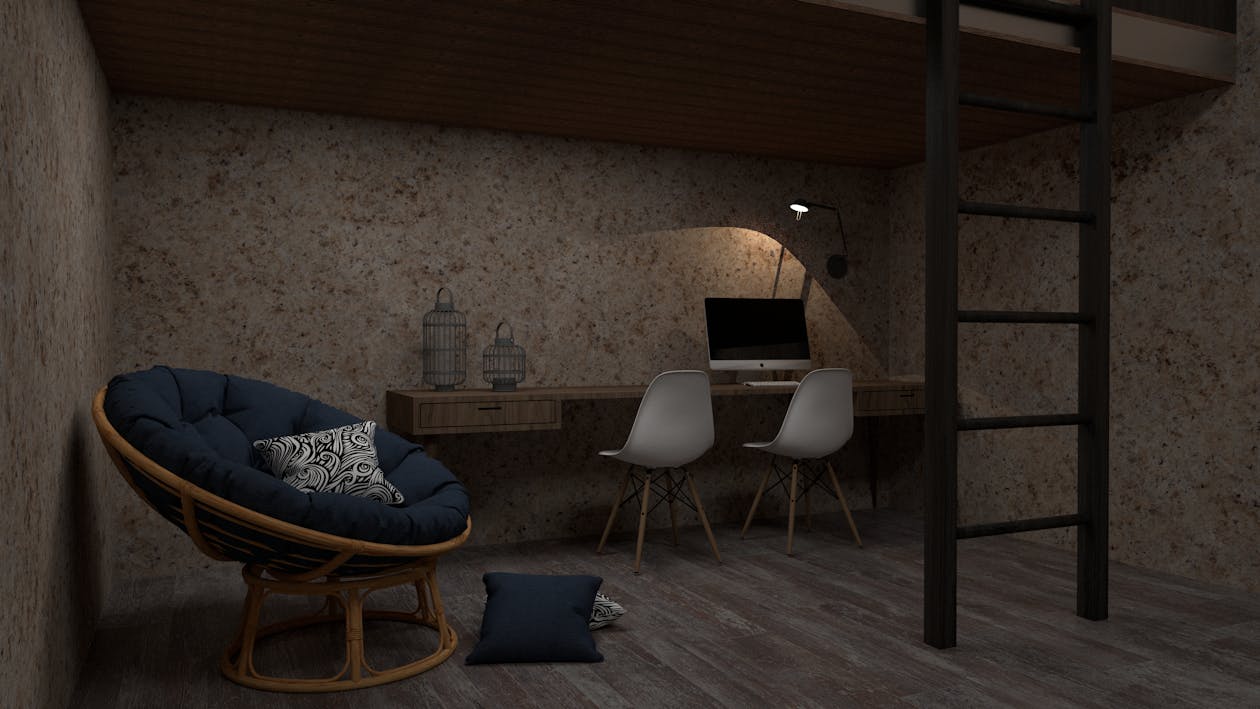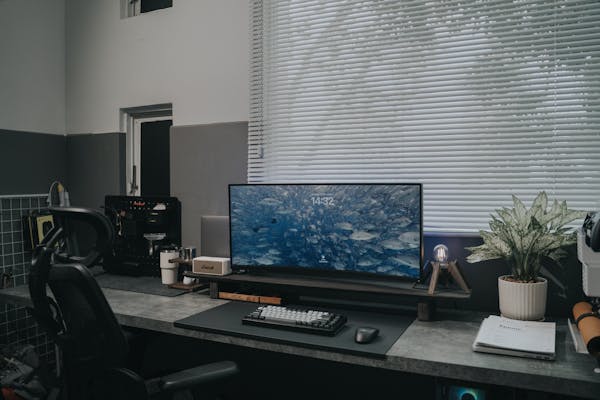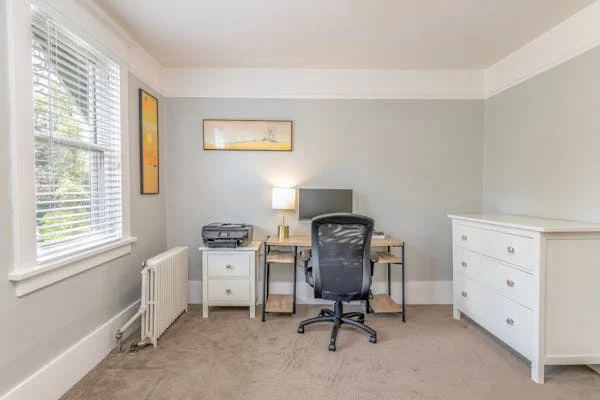
Table of Contents
ToggleAffordable Ergonomic Desk Setup for Home Office: 7 Easy Ways to Boost Comfort and Productivity
When setting up your home office, ergonomics should be at the top of your list. Not only does an affordable ergonomic desk setup help prevent long-term health issues, but it also significantly enhances productivity and comfort. Spending long hours at a desk can cause discomfort and physical strain, especially if your workspace isn’t designed with ergonomics in mind. The good news is, you don’t need to spend a fortune to create a setup that promotes proper posture, reduces strain, and boosts your efficiency. A well-planned affordable ergonomic desk setup for home office ensures that you can work comfortably without the risk of strain or injury.
This guide will show you how to create an affordable ergonomic desk setup for your home office, from selecting the right furniture to making budget-friendly adjustments. Whether you’re working full-time or part-time, these tips will help you design a comfortable, supportive workspace that enhances focus and reduces discomfort. You don’t need expensive furniture—simple changes can provide the same health benefits while keeping your budget intact. Creating an affordable ergonomic desk setup is more accessible than you might think.
What is Ergonomics?
Ergonomics is the science of designing workspaces and tools that are optimized for comfort, efficiency, and safety. In a home office, ergonomics focuses on adjusting your workspace to reduce physical strain and encourage proper posture. The aim is to minimize discomfort, prevent injuries such as repetitive stress injuries (RSI), and enhance productivity, allowing you to work longer without experiencing pain or fatigue.
When it comes to creating an affordable ergonomic desk setup for your home office, the key is making strategic adjustments that are both budget-friendly and effective. By following ergonomic principles, you can avoid common issues like neck pain, back pain, eye strain, and wrist discomfort, which are often caused by poorly arranged workstations.
Implementing an affordable ergonomic desk setup involves making thoughtful choices about furniture, accessories, and your overall desk arrangement. Simple, cost-effective adjustments such as using adjustable chairs, lumbar cushions, and monitor stands can make a significant impact. Additionally, the right posture and desk layout play crucial roles in maintaining your comfort and health.
Investing time in setting up an affordable ergonomic desk setup doesn’t just improve your physical well-being. It can also help enhance your work experience, leading to better focus, productivity, and overall job satisfaction. With the right tools and a little creativity, you can design a workspace that supports both your health and professional success.
The Benefits of an Ergonomic Workspace
An affordable ergonomic desk setup for your home office brings several significant benefits:
- Reduces physical strain: Ergonomics helps minimize strain on muscles and joints, preventing discomfort that could lead to chronic pain. A well-designed ergonomic workspace promotes healthier sitting and standing positions, reducing the risk of back and neck strain. With the right desk, chair, and monitor placement, you can work longer hours without fatigue.
- Boosts productivity: Comfort leads to focus. When you’re not distracted by discomfort or pain, you’re able to work for longer periods with fewer interruptions. An affordable ergonomic desk setup for home office encourages better posture and an organized workspace, boosting workflow efficiency. A streamlined, ergonomic setup allows you to complete tasks more effectively and with greater ease.
- Enhances posture: Proper alignment reduces strain on your neck, back, and spine. An ergonomic desk setup helps you maintain proper posture throughout the day, avoiding slouching or craning your neck toward the screen, which can lead to long-term spinal issues. Regular use of an ergonomic chair and desk encourages an aligned, neutral spine.
- Prevents injuries: An ergonomic setup greatly reduces the risk of repetitive stress injuries like carpal tunnel syndrome, tendonitis, and back pain. These injuries are common in poorly designed workspaces but can be prevented with an affordable ergonomic desk setup that promotes neutral wrist positioning, proper desk height, and adequate lumbar support.

Key Elements of an Affordable Ergonomic Desk Setup
Building an affordable ergonomic desk setup for your home office doesn’t require large investments. Focus on these essential elements to create a comfortable, health-promoting workspace:
- Adjustable Desk Height: Ensure your desk allows for the proper sitting or standing posture. If a fully adjustable desk is out of your budget, consider a standing desk converter as part of your Affordable Ergonomic Desk Setup.Ergonomic Chair: Choose a chair that provides proper lumbar support, supports your spine’s natural curve, and has adjustable seat height and armrests. These are key features for an Affordable Ergonomic Desk Setup that ensures comfort throughout the workday.Monitor Setup: Your monitor should be at eye level, about an arm’s length away, to reduce neck and eye strain. Use a monitor stand to help achieve this, promoting a neutral head position and reducing neck pain. This simple adjustment is an essential part of an Affordable Ergonomic Desk Setup.Keyboard and Mouse Placement: Keep your keyboard and mouse at elbow height to reduce strain on your wrists and arms. Consider ergonomic accessories like a split keyboard or wrist rest to improve comfort further. These small but effective changes are crucial to creating an Affordable Ergonomic Desk Setup.
By incorporating these elements into your home office design, you can create a cost-effective ergonomic workspace that promotes good posture, reduces discomfort, and enhances your work experience. An Affordable Ergonomic Desk Setup is achievable with careful planning and smart choices.
1. Choosing the Right Desk for Your Budget
The desk is the foundation of your ergonomic desk setup. Selecting the right one is crucial, but you don’t need to overspend to create a functional workspace.
- Desk Height: The desk should allow you to keep your elbows at a 90-degree angle when seated. The ideal desk height ensures your forearms are parallel to the floor. Consider desks with adjustable height options for added flexibility, allowing you to switch between sitting and standing throughout the day.
- Desk Size: If you’re on a budget, opt for a desk that provides ample space without being oversized. A simple, flat surface with enough room for your computer, keyboard, and essential work tools is ideal. Avoid large, expensive desks that take up unnecessary space.
- Desk Options: Explore affordable adjustable standing desks or desk converters to alternate between sitting and standing. These versatile options can improve your ergonomics, health, and productivity, helping you reduce the strain of prolonged sitting.

2. Ergonomic Chairs That Won’t Break the Bank
An ergonomic chair is a critical component of your affordable ergonomic desk setup. Your chair should offer adequate support and be adjustable to maintain comfort throughout the day.
- Lumbar Support: Choose a chair that supports the natural curve of your spine. Built-in lumbar support is ideal, but you can also add a lumbar cushion to enhance comfort if your chair doesn’t provide enough support.
- Seat Height and Depth: The seat height should be adjustable, ensuring your feet are flat on the floor and your knees form a 90-degree angle. The depth of the seat should allow you to sit with your back against the seat, leaving 2-4 inches of space behind your knees to avoid discomfort.
- Affordability: There are plenty of affordable ergonomic chairs available online, and second-hand options can be a great way to find a high-quality chair without the hefty price tag. Look for sales or check discount stores for deals on ergonomic models that offer great value and comfort.
3. Optimizing Your Monitor Setup for Comfort
An often overlooked aspect of an affordable ergonomic desk setup is the positioning of your monitor. Proper monitor placement can significantly reduce neck and eye strain, enhancing comfort during long work hours.
- Monitor Height: Your monitor should be positioned at or slightly below eye level to prevent neck strain. Keeping your head in a neutral position allows for a more comfortable viewing angle and reduces the risk of developing neck pain over time.
- Screen Distance: Place your monitor about an arm’s length away from your eyes, with the top of the screen at or just below eye level. This reduces strain on your eyes and neck, helping you maintain focus without discomfort.
- Use a Monitor Stand: If your monitor doesn’t have adjustable height, consider an affordable monitor stand. Many budget-friendly options are available online to raise your monitor to the optimal height, improving ergonomics without breaking the bank.
4. Desk Layout for Better Ergonomics
The way you arrange your desk can have a significant impact on your comfort and productivity. A well-organized, ergonomic desk layout reduces strain and promotes better posture.
- Keyboard and Mouse Placement: Keep your keyboard and mouse close to your body, ensuring your forearms remain parallel to the floor. This minimizes the need to reach, reducing strain on your shoulders, arms, and wrists.
- Monitor Position: Position your monitor directly in front of you to avoid unnecessary neck strain. You should not have to twist or turn your head to view the screen. Proper monitor placement ensures you maintain good posture and reduce discomfort.
- Organize Your Workspace: A clutter-free desk is essential for an ergonomic setup. Keep only the essentials within easy reach to reduce the need for stretching or twisting, which can lead to poor posture and discomfort. A well-organized workspace can also boost productivity and reduce distractions.
5. Footrests and Wrist Supports
Sometimes, small additions can make a significant impact on your affordable ergonomic desk setup. These accessories enhance comfort and help prevent strain during long hours of work.
- Footrests: If your chair is too high or your feet don’t comfortably reach the floor, a footrest can make a huge difference. It helps support proper posture and alignment, ensuring your knees are at a 90-degree angle and your feet are flat on the floor.
- Wrist Rests: Adding a wrist rest to your keyboard and mouse setup can reduce strain on your wrists. This helps maintain a neutral wrist position, minimizing the risk of repetitive stress injuries like carpal tunnel syndrome, which are common in poorly set up workspaces.
- Lumbar Cushions: If your chair lacks proper lumbar support, a lumbar cushion is a cost-effective solution to improve lower back support. It helps maintain the natural curve of your spine, improving spinal alignment and overall comfort.
6. Lighting and Its Impact on Comfort
Proper lighting is a key factor in reducing eye strain, enhancing focus, and ensuring a comfortable work environment in an ergonomic desk setup. A well-lit workspace can significantly improve your overall comfort and productivity, making it an essential component of an affordable ergonomic home office setup.
- Natural Light: Natural light is the best source of illumination, as it not only brightens your workspace but also boosts your mood and energy levels. Whenever possible, position your desk near a window to take advantage of natural daylight. Exposure to natural light during the day helps regulate your body’s circadian rhythm, promoting better sleep patterns and improving alertness. If your workspace lacks natural light, try using full-spectrum bulbs that mimic daylight and improve ergonomics without breaking the bank. Natural light is an essential element of an ergonomic home office setup.
- Task Lighting: Task lighting is essential in an ergonomic home office design, as it provides focused illumination for specific tasks, such as reading, writing, or working on your computer, without causing shadows or glare. An adjustable desk lamp is an ideal choice because it allows you to direct the light exactly where you need it. Look for ergonomic desk lamps that are dimmable, so you can adjust the light intensity based on the time of day and your needs. Task lighting reduces eye strain by providing adequate light for detailed work and creates a pleasant ambiance for your affordable ergonomic home office.
- Blue Light Filters: Spending long hours in front of a screen exposes your eyes to blue light, which can lead to eye strain, headaches, and even disrupt your sleep cycle. Blue light filters are designed to reduce the amount of blue light emitted by your screen, minimizing strain on your eyes. Many monitor software solutions are available that adjust the color temperature of your screen, making it warmer and more comfortable to look at. Alternatively, you can invest in a physical blue light screen protector or blue light glasses designed to block harmful blue light. Reducing blue light exposure, especially in the evening, will help you wind down and maintain healthy sleep patterns, contributing to overall well-being in your ergonomic desk setup.

7. Regular Breaks and Posture Adjustments
While setting up an ergonomic desk is essential, developing healthy work habits is just as important for maintaining comfort and preventing injuries. Regular breaks and posture adjustments are key to optimizing the effectiveness of your affordable ergonomic desk setup.
- Take Breaks Every 30 Minutes: Sitting in one position for long stretches of time can contribute to stiffness, muscle fatigue, and poor circulation. Even the most ergonomic chair or desk setup won’t prevent these issues if you remain sedentary for hours. To combat this, set a timer or use an app that reminds you to take breaks every 30 minutes. During these breaks, stand up, stretch, or take a quick walk around your home office. These short breaks promote blood circulation, relieve muscle tension, and reduce the risk of repetitive stress injuries. Incorporate stretches that target the lower back, neck, shoulders, and wrists to keep muscles relaxed, ensuring long-term workplace health in your ergonomic home office setup.
- Change Positions Regularly: Alternating between sitting and standing is one of the best ways to prevent stiffness and discomfort in your ergonomic desk setup. If your desk setup includes a standing desk converter or an adjustable standing desk, use it to switch between positions throughout the day. For instance, stand while taking calls or reading emails, and sit when typing or working on detailed tasks. If you don’t have an adjustable desk, simply adjusting the height of your chair or switching to a different seating position can relieve pressure on specific muscle groups. Changing positions regularly helps reduce the load on your spine, neck, and joints, preventing long-term discomfort and encouraging a healthy ergonomic workspace.
- Be Mindful of Your Posture: Regardless of whether you’re sitting or standing, maintaining good posture is essential for minimizing strain. When seated, ensure that your back is supported by the chair’s lumbar support, and that your feet are flat on the floor (or on a footrest if necessary). Your knees should be at a 90-degree angle, and your hips should be aligned with your knees to maintain good posture. When standing, keep your weight evenly distributed between both legs, avoid locking your knees, and keep your spine straight. By being mindful of your posture throughout the day, you can prevent tension and reduce the risk of developing chronic pain, all while maintaining a productive and ergonomic home office setup.
By following these ergonomic habits, you can ensure that your affordable ergonomic desk setup remains effective and comfortable over time. Regular movement, mindful posture adjustments, and attention to lighting will help you maintain productivity and reduce physical strain, creating a workspace that promotes long-term health and efficiency. These small, budget-friendly changes ensure that your ergonomic home office remains a comfortable, productive, and healthy place to work.
Conclusion
Creating an affordable ergonomic desk setup for your home office doesn’t have to be expensive. With the right ergonomic desk, chair, monitor setup, and simple adjustments, you can improve comfort, health, and productivity. Small changes like lumbar cushions, monitor stands, and ergonomic accessories can prevent discomfort and boost efficiency.
Choosing an ergonomic chair, positioning your monitor at eye level, and using wrist rests or footrests can optimize your workspace. These budget-friendly upgrades reduce strain, improve posture, and enhance your work experience.
Investing in an ergonomic desk setup helps prevent long-term discomfort, boosts productivity, and promotes a healthier work-life balance.
You can also read more ergonomic home office design ideas here.
FAQ: Affordable Ergonomic Desk Setup for Home Office
1. What is the best budget ergonomic chair?
Look for chairs with adjustable lumbar support and height. Many affordable options are available online that provide essential ergonomic features without costing much.
2. Can I use a regular desk for an ergonomic setup?
Yes, as long as the desk is the right height and allows you to sit comfortably. You can adjust the height with accessories like adjustable risers or use a standing desk converter.
3. What is the ideal screen height for my desk?
The top of your monitor should be at or just below eye level, with the screen about an arm’s length away from your face to avoid neck and eye strain.
4. How often should I take breaks to maintain good posture?
Aim to take breaks every 30 minutes, standing up, stretching, and adjusting your posture. This helps prevent stiffness and improves circulation.
5. Do I need a footrest for my ergonomic desk setup?
If your feet don’t reach the floor comfortably, a footrest can help maintain proper posture and reduce pressure on your lower back.
6. Are lumbar cushions really necessary?
If your chair doesn’t offer built-in lumbar support, a cushion can help support the natural curve of your spine and improve comfort.
7. Can I create an ergonomic setup without spending a lot of money?
Absolutely! There are many budget-friendly options for ergonomic chairs, desks, and accessories like monitor stands and wrist rests.
8. What accessories are essential for a budget ergonomic setup?
Essential accessories include a monitor stand, wrist rest, lumbar cushion, and a good desk lamp to reduce eye strain

